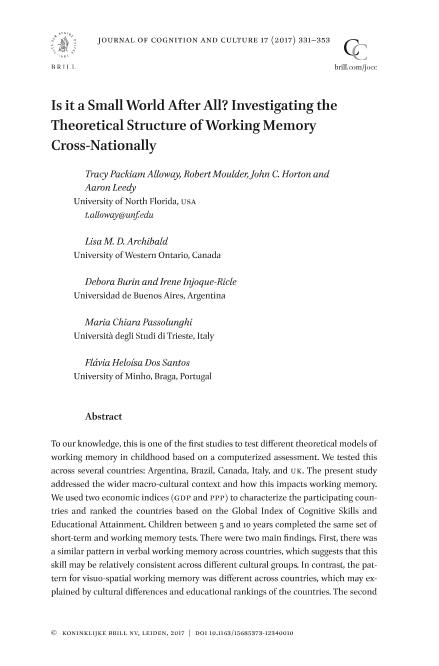Artículo
Is it a Small World After All? Investigating the Theoretical Structure of Working Memory Cross-Nationally
Alloway, T. P.; Moulder, R.; Horton, J. C.; Leedy, A.; Archibald, L.M.D.; Burin, Debora Ines ; Injoque Ricle, Irene
; Injoque Ricle, Irene ; Passolunghi, M. C.; Dos Santos, F. H.
; Passolunghi, M. C.; Dos Santos, F. H.
 ; Injoque Ricle, Irene
; Injoque Ricle, Irene ; Passolunghi, M. C.; Dos Santos, F. H.
; Passolunghi, M. C.; Dos Santos, F. H.
Fecha de publicación:
10/2017
Editorial:
Brill Academic Publishers
Revista:
Journal of Cognition and Culture
ISSN:
1568-5373
Idioma:
Inglés
Tipo de recurso:
Artículo publicado
Clasificación temática:
Resumen
To our knowledge, this is one of the first studies to test different theoretical models of working memory in childhood based on a computerized assessment. We tested this across several countries: Argentina, Brazil, Canada, Italy, and uk. The present study addressed the wider macro-cultural context and how this impacts working memory. We used two economic indices (gdp and ppp) to characterize the participating countries and ranked the countries based on the Global Index of Cognitive Skills and Educational Attainment. Children between 5 and 10 years completed the same set of short-term and working memory tests. There were two main findings. First, there was a similar pattern in verbal working memory across countries, which suggests that this skill may be relatively consistent across different cultural groups. In contrast, the pattern for visuo-spatial working memory was different across countries, which may explained by cultural differences and educational rankings of the countries. The second main finding was that both a domain-general model (3-factor) and a domain-specific model (4-factor) provided a reasonably good fit with the data, there was the high relationship between the verbal and visuo-spatial working memory constructs across the countries in the latter model. Thus, it may be a more parsimonious choice to rely on a three-factor model. The data also suggest culture-similar patterns in a computerized assessment of working memory.
Archivos asociados
Licencia
Identificadores
Colecciones
Articulos(SEDE CENTRAL)
Articulos de SEDE CENTRAL
Articulos de SEDE CENTRAL
Citación
Alloway, T. P.; Moulder, R.; Horton, J. C.; Leedy, A.; Archibald, L.M.D.; et al.; Is it a Small World After All? Investigating the Theoretical Structure of Working Memory Cross-Nationally; Brill Academic Publishers; Journal of Cognition and Culture; 17; 3-4; 10-2017; 331-353
Compartir
Altmétricas



